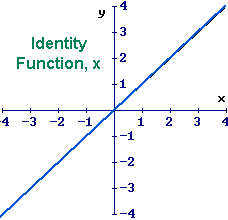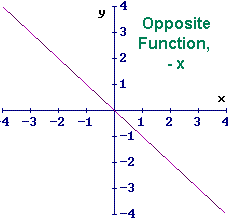 where n the
exponent is 1 and a the
coefficient is 1.
where n the
exponent is 1 and a the
coefficient is 1.


This is the most important functions. The rule it describes is as follows: use the x value as the y value. The x and the y value in each ordered pair are identically the same, hence, it is called the identity function.
It is
linear. It is a first degree
polynomial because it may
be written as y = x or  where n the
exponent is 1 and a the
coefficient is 1.
where n the
exponent is 1 and a the
coefficient is 1.
Its slope is 1 because the coefficient of the x term is 1. Its reciprocal is 1/x. It is its own inverse: the inverse function for y = x is y = x.
The identity function may be thought of as the basis for all other functions. The linear function y = x + 3, or just x + 3, may be thought of as the sum of the identity function, x, and the constant function 3. The linear function y = 4x, or just 4x, may be thought of as the product of the identity function, x, and the constant function 4. The quadratic function y = x², or just x², may be thought of as the square of the identity function, x · x, or xx, or x².

The opposite function returns the opposite of whatever number is operated upon. If one takes the opposite of a positive, the result is negative. If one takes the opposite of a negative, the result is positive. The opposite of zero is zero.
It is linear. Its slope is -1. Its reciprocal is -1/x. It is its own inverse: the inverse function is -x.
Graphically the opposite is useful in reflecting a curve about a vertical axis or a horizontal axis.

 | ![[MC,i. Home]](http://www.mathnstuff.com/math/spoken/here/1gif/mcihome.gif)
![[Table]](http://www.mathnstuff.com/math/spoken/here/1gif/table.gif)
![[Words]](http://www.mathnstuff.com/math/spoken/here/1gif/words.gif)

![[this semester's schedule w/links]](http://www.mathnstuff.com/gif/semestr.gif)
![[Good Stuff -- free & valuable resources]](http://www.mathnstuff.com/gif/goods.gif)
![[next]](http://www.mathnstuff.com/math/spoken/here/1gif/next.gif)
![[last]](http://www.mathnstuff.com/math/spoken/here/1gif/last.gif)
© 2005, 2019, Agnes Azzolino www.mathnstuff.com/math/spoken/here/2class/300/fx/library/most.htm |